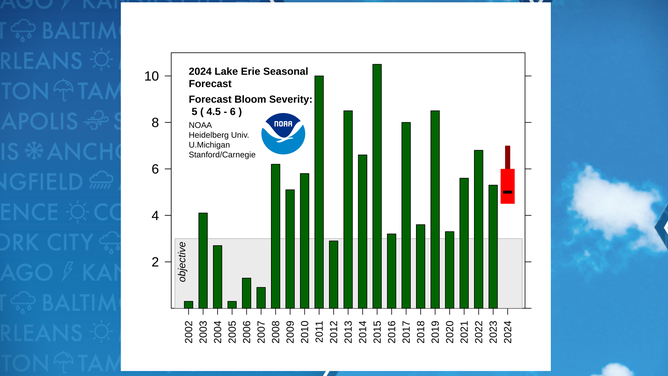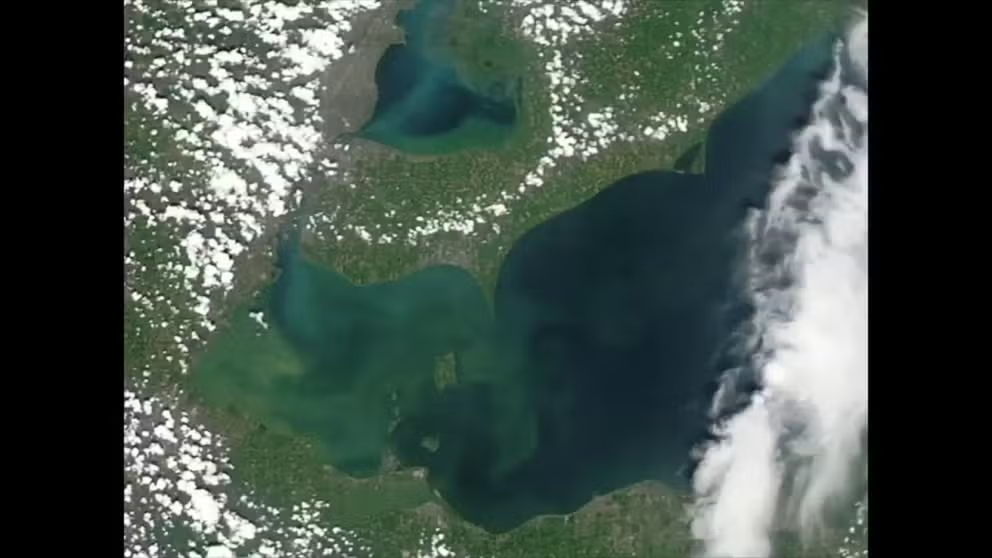Harmful algae blooms in Great Lakes could increase this summer, NOAA warns
Lake Erie is the fourth largest of the five Great Lakes, and algae is common when water temperatures are the warmest. NOAA says the bloom’s severity depends on how much phosphorus makes its way from rivers and creeks into the lake.
Lake Erie water quality flight overview
Engineers at NASA's Glenn Research Center in Cleveland used remote-sensing technology to learn more about a Lake Erie algal bloom in 2014 .
CLEVELAND – NOAA is closely monitoring the Great Lakes this summer for potential increases in harmful algae that could have economic impacts and affect ecosystems.
The agency released its seasonal outlook Thursday, predicting Lake Erie’s algae levels would range between 4.5 and 6, with an anticipated average of about 5.
These levels are considered to be below the severe threshold but are comparable to last year’s average of 5.3.
Depending on the location of the algae, levels of 5 or greater on the severity index are known to pose a risk to drinking water and recreation along the lake.
The annual bloom, commonly known as blue-green algae, is expected to become visible by early July and last into September.
"The blooms in Lake Erie are changing. They are developing earlier over the past 10 years than previously, for reasons we do not yet understand," Richard Stumpf, a lead scientist for the seasonal Lake Erie bloom forecast, said in a statement. "An early start does not necessarily lead to a larger bloom, but it does mean the bloom lasts longer."

Bloom severity forecast compared to previous years
(NOAA)
WARM WINTER LEADS TO RECORD-LOW ICE ALONG GREAT LAKES
The largest bloom ever happened in 2015 and reached a value of 10.5 on the severity index. Just a year earlier, water quality alerts were issued in Toledo, Ohio, due to unsafe levels of microcystins.
If ingested, microcystins can cause adverse health effects in people and animals, ranging from skin rashes to serious illness and even death.
Significant rainfall events around industrial and agricultural operations can lead to the runoff of phosphorus into rivers and streams, which empty into the lakes and lead to the production of toxins.
NOAA, in combination with its partners, have maintained a goal of keeping summer levels below 3, which hasn’t happened since 2012.
"Understanding hazards such as harmful algal blooms helps us ensure the Great Lakes are a power in the Blue Economy," Nicole LeBoeuf, director of NOAA’s National Ocean Service, stated. "As the science behind our forecasts improves, we can give communities better information to plan for varying blooms."
WATCH: LAST BITS OF ICE HUG LAKE ERIE SHORE AMID NEAR-RECORD ICE MELT
During previous dry spells, observers have noted that the bloom has appeared to be less significant, which was attributed to reduced runoff.
NOAA plans on issuing additional reports on the status of the bloom throughout the summer for users of the waterways and the estimated 30 million people who rely on the lakes for drinking water.
"NOAA’s Lake Erie HAB forecast continues to be an important tool to help inform decisions made by drinking water treatment plants, local governments and individuals visiting Lake Erie’s shoreline and recreating on its waters," Christopher Winslow, director of Ohio Sea Grant and Stone Laboratory, stated. "Additionally, data collected before and during each bloom season continues to inform management decisions related to nutrient management and bloom response."




